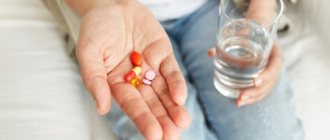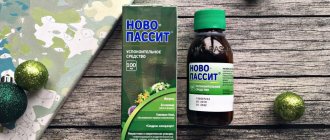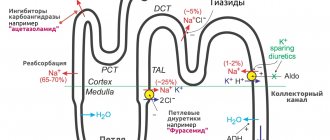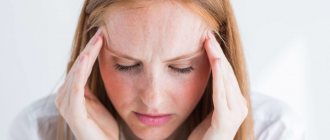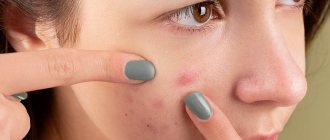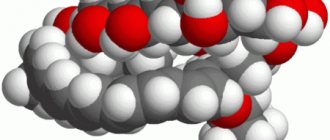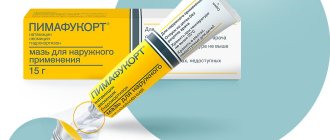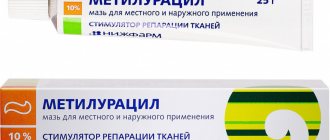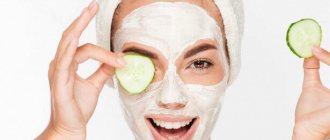In clinical practice, dermatovenerologists daily encounter patients suffering from steroid-sensitive dermatoses (simple and allergic contact dermatitis, atopic dermatitis, eczema, seborrheic dermatitis, etc.) [1-5]. The results of domestic and foreign studies have shown the important role of skin microflora in the development of allergic dermatoses: skin hypersensitivity to a number of antigenic stimuli, especially pathogenic antigens; a decrease in the resistance of the skin barrier to pathogenic and opportunistic microflora, which in turn is one of the important reasons for the recurrent course of diseases. It has been described that the microbial flora of the skin in a significant proportion of patients with allergic dermatoses (45-90%) causes and aggravates the course of the underlying disease [1]. It has been proven that mild and moderate atopic dermatitis is accompanied by bacterial contamination of the skin with Staphylococcus aureus,
reaching 60-100% [6]. A high level of skin contamination with microorganisms is facilitated by the structure and function of the epidermal barrier in chronic dermatoses: an increase in transepidermal water loss, changes in the function of the acid mantle, impaired desquamation and other factors [7]. In this regard, eliminating the effect of various infectious agents in dermatoses of combined etiology is a key direction in the treatment of patients [2]. At the same time, topical glucocorticosteroids (GCS) remain the drugs of choice in the treatment of allergic dermatoses, including those complicated by secondary infection [8–13].
For practicing dermatovenerologists, it is important to have in their arsenal a combined topical GCS in the form of a cream and ointment, which solves the problems of patients with complicated dermatoses [9, 10].
As part of the import substitution program, practicing doctors will be interested in the Russian-made combination drug Akriderm GK
. It is available in the form of a cream and ointment and contains betamethasone dipropionate, gentamicin sulfate and clotrimazole. Betamethasone dipropionate has anti-inflammatory, antiexudative, antiallergic and antipruritic effects. Gentamicin has a wide antibacterial spectrum, and clotrimazole, an antifungal component from the azole group, significantly expands the spectrum of action and use of the drug in dermatological practice [1, 13].
The purpose of this study is to evaluate the clinical effectiveness, safety profile and tolerability of the external combined glucocorticosteroid drug Akriderm GK
(beta-amethasone + gentamicin + clotrimazole) in the form of cream and ointment in the daily practice of a dermatovenerologist in the treatment of patients with steroid-sensitive dermatoses complicated by secondary bacterial and/or fungal infection.
What is post-acne
Acne can appear on the face and neck, in the interscapular area, on the back and in the upper chest. Acne or acne is the formation of inflammatory elements on the skin - compacted reddened tubercles (papules) and blackheads, purulent white heads with redness around them. If elements are injured, squeezed out or heal poorly, post-inflammatory, scarring, and pigmentary changes form on the skin - this is post-acne.
This is what post-acne looks like
Pharmacodynamics
The corticosteroid betamethasone dipropionate inhibits the accumulation of leukocytes, the release of lysosomal enzymes and pro-inflammatory mediators at the site of inflammation, inhibits phagocytosis, reduces vascular tissue permeability, and prevents the formation of inflammatory edema.
Gentamicin is a broad-spectrum antibiotic from the aminoglycoside group. Has a bactericidal effect against pathogens of primary and secondary bacterial skin infections. Active against gram-negative bacteria: Pseudomonas aeruginosa, Aerobacter aerogenes, Escherichia coli, Proteus vulgaris, Klebsiella pneumoniae; gram-positive bacteria: Streptococcus spp. (susceptible strains of group A beta- and alpha-hemolytic streptococcus), Staphytococcus spp. (coagulase-positive, coagulase-negative and some penicillinase-producing strains). Inactive against anaerobes, fungi and viruses.
Clotrimazole has an antifungal effect by disrupting the synthesis of ergosterol, which is an integral part of the cell membrane of fungi. Active against: Trichophyton rubrum, Trichophyton mentagrophytes, Epidermophyton floccosum, Microsporum canis, Candida albicans, Malassezia furtur (Pityrosporum orbiculare).
Salicylic acid provides a keratolytic, antimicrobial effect, eliminates horny layers and promotes deeper penetration of GCS.
Reasons for the appearance and areas of localization of post-acne
The skin is the largest organ in the human body, and it has a complex structure. In addition to the epithelial cells that form the continuous skin, there are also hair follicles, sweat and sebaceous glands. It is the glands that secrete sebum and form a protective hydrolipidic mantle on the surface of the epithelium that suffer during the development of acne.
To begin with, it is important to understand why acne occurs. When the sebaceous glands malfunction, the epithelium in the area of the ducts thickens, the lumen of the gland narrows and sebum cannot be regularly and fully released through the pores to the surface. Then the fatty secretion is retained inside the gland duct itself, which provokes inflammation with the participation of microbes that are constantly present on the surface of the skin, making up its microflora.
The process of acne formation goes through certain stages:
Initially, comedones are formed - an increase in the size of the sebaceous gland. Nodules form in the skin with an irritated opening of the sebaceous gland. As the process develops, black dots form in the center, and disturbances in the outflow of sebum, microbial activity, and the work of leukocytes during inflammation lead to the formation of purulent heads (pustules).
By themselves, these elements can leave behind scars and uneven skin, and if they are further injured, if you squeeze out blackheads or purulent heads, the inflammation only intensifies, and the purulent contents can spread to neighboring areas of the skin.
To prevent inflammation from spreading, to prevent damage to more and more areas of tissue, and to prevent pus from penetrating into neighboring areas, inflammatory changes form around the damage to the sebaceous gland.
Swelling occurs in the area of the pimple, collagen production is stimulated, scar changes are formed: connective tissue elements are formed, new capillaries grow, which gives redness, the work of pigment cells is stimulated - pigment spots are formed - persistent and with uneven edges.
Especially often, problems arise on the face, mainly in the forehead, on the nose and cheeks, on the chest, they also appear in the décolleté or on the back.
Redness disappears over time, pigmentation becomes less bright, scars can atrophy, forming dimples, or, conversely, become convex and rough.
conclusions
This clinical study proves the high effectiveness, safety and tolerability of Akriderm GK
(betamethasone + gene-tamycin + clotrimazole) in the treatment of steroid-sensitive dermatoses complicated by bacterial and/or fungal infection.
The drug Akriderm GK
(betamethasone + gentamicin + clotrimazole) can be recommended for the treatment of dermatoses that occur both chronically (ointment) and with acute inflammatory phenomena (cream).
Dosage forms of the drug Akriderm GK
in the form of cream and ointment make it possible to treat dermatoses with different localizations.
The duration of use of the drug under the supervision of a physician can be from 7 days (allergic contact dermatitis) to 14 days (for example, when treating athlete's foot inguinal). The drug Akriderm GK
(betamethasone + gentamicin + clotrimazole) is produced in Russia, which is important within the framework of import substitution programs.
There is no conflict of interest.
Types and stages of post-acne
Among the main signs of post-acne, hyperpigmentation is identified - these are areas of normally colored and darker skin, alternating with each other and forming an uneven tone.
In addition, the typical presence of stagnant red spots, enlarged skin pores, often filled with sebum, as well as pathological scars. In the area of blockage of the sebaceous glands, atheromas (sebaceous gland cysts filled with fatty secretions) or milia (whiteheads) are formed.
The main sign of post-acne is old cicatricial changes, scars after healed purulent acne. They can take three forms:
- depressed areas of skin, dimples (or atrophic scars);
- convex, lumpy areas, often with areas of erythema (hypertrophic);
- areas of dyschromia (the surface of the skin is spotty, with areas of increased pigmentation).
Sometimes the formation of keloid scars is mistakenly added to the classification. This is the wrong approach. People with a hereditary predisposition to the formation of rough and poorly healing scars that disfigure the appearance do not often suffer from acne, and therefore post-acne phenomena are rare for them.
The most common type of post-acne is the appearance of atrophic scars. According to the Jacob CI classification, they can take the form of rounded, chipped and square elements. This division helps doctors plan treatment and predict its results.
Round scars are the shallowest, and the prognosis for them is the most favorable. The square ones are somewhat deeper, but are also eliminated quite well. The biggest problem is the chipped forms of post-acne, they look like the Latin letter “V”, their bottom is located deep in the dermis.
Types of skin damage from acne
Indications for use
Akriderm GENTA is a drug with wide application possibilities. Prescribed primarily for the treatment of diseases that respond well to glucocorticosteroid therapy. Such pathologies include:
- dermatitis (simple and allergic), especially secondary infections;
- eczema (atopic, childhood, coin-shaped);
- atopic dermatitis (diffuse neurodermatitis);
- simple chronic lichen (limited neurodermatitis);
- solar dermatitis;
- exfoliative dermatitis;
- radiation dermatitis;
- diaper rash;
- psoriasis;
- itching
Ways to get rid of post-acne
The intensity of post-acne is directly related to the severity of acne. Therefore, it is important to work not only to eliminate the consequences, but also to prevent the appearance of new elements on the skin. It is necessary to fight acne itself, eliminating its main causes. If pimples appear again and again, the prognosis for post-acne treatment is questionable; inflammation will give rise to new scars. Therefore, work with an experienced dermatologist-cosmetologist is required.
Most of the work on restoring, smoothing the skin and eliminating scars is carried out by a cosmetologist, but certain activities can also be performed at home. Moreover, only an integrated approach will give the most maximum results.
What can you do at home?
At home, you need to help the skin recover; it needs building elements and proper nutrition. To regenerate the skin and form its structure, it is necessary to supply vitamins and minerals, protein as a source of amino acids for the construction of collagen fibers and the synthesis of hyaluronic acid, which moisturizes and gives the skin tone and smoothness.
In addition, omega acids are important, which are involved in cell renewal and form cell membranes. It is important to adjust your diet, eliminate as much processed foods as possible, food chemicals (dyes, preservatives, E-additives) and give up bad habits.
To prevent new acne and improve tone, nourish the skin, heal inflammation and small scars, pharmaceutical products will help. You can use 1% salicylic alcohol or boric acid and wipe the skin with it twice a day. Levomekol ointment works quite well in treating acne, suppressing inflammation and eliminating scars. Many people use bodyaga powder, which is diluted in water to a paste and applied to the affected area. But before using all these remedies, it is important to first consult with your doctor to prevent side effects and complications.
Skin care is complemented by serums, care creams (day and night) selected by a cosmetologist, as well as homemade peelings with fruit acids. They delicately exfoliate the skin, remove dead cells, and cleanse its surface.
Folk remedies are often used, for example, infusions of St. John's wort and chamomile, which have an anti-inflammatory, soothing, cleansing effect. You can freeze them and wipe the skin with the resulting ice cubes, further increasing blood circulation and capillary tone.
You can also use masks with blue clay. The recipe for making a mask is very simple: three tablespoons of powder are diluted in water to a paste, applied to the problem area for 20 minutes and then thoroughly washed off with water.
What treatment methods are used in a cosmetology clinic?
Although homemade recipes help in the fight against post-acne, you should not think that only through them you can eliminate all problems. Home methods act on the very top layers of the skin and reduce only minor defects.
Modern cosmetic procedures will help get rid of deep scars, pigmentation and unevenness. But don't expect instant results.
Treatment methods are selected individually and comprehensively. The more severe the initial problem and the wider the affected area, the longer the treatment will be.
To achieve maximum smoothness of the skin and an even complexion or eliminate blemishes on the body, you need a whole series of procedures, supplemented by home care and carefully selected cosmetics. On average, the first noticeable results will be visible after 1-2 months with regular implementation of all necessary treatment measures.
If there is unevenness, decreased skin tone, pigmented or stagnant spots, peelings . There are a lot of treatment options: these can be mechanical peels (compositions with herbs, small dense particles) and chemical peels (with retinol, glycolic, resorcinol or other compounds).
With mechanical peeling, the effect of cleansing and exfoliation is achieved due to the mechanical scraping of the particles included in the composition of the upper layer of skin with outdated epithelial cells.
With chemical peeling, a similar effect is achieved through chemical cauterization of the upper layer of the epidermis, which leads to its subsequent rejection with peeling.
The cosmetologist selects peelings to suit your needs and strictly follows all the rules for their implementation in order to achieve maximum effect and avoid side effects. On average, the first results are visible after 5-6 procedures.
A more effective analogue of peeling is laser skin resurfacing . The doctor performs the procedure with a special laser unit with a strictly specified wavelength in order to influence the skin at the required depth without damaging neighboring tissues. The laser beam cauterizes the skin, the treated areas are actively exfoliated, which allows stimulating the regeneration of new tissues, more even and smooth.
Check out our patient's review of laser facial resurfacing:
Photothermolysis is a more advanced method of laser skin treatment. The rays do not act as a continuous field, but as individual points - creating a mesh on the treated area. This is a fairly effective, but less traumatic effect; the rehabilitation period after such procedures is reduced.
dermabrasion is used to combat skin imperfections . This is the use of aluminum oxide powder under pressure or a special rotating abrasive disc for mechanical grinding of the skin, removing the upper layers of the epidermis from it.
Filler injections can help eliminate atrophic scars and dimples and smooth out the skin . They are inserted under the defect area, create additional volume, and lift depressed skin. The effect lasts up to 6-10 months (depending on the drug), then the injections are repeated.
Mesotherapy with drugs that stimulate collagen synthesis and epidermal renewal gives good results A series of microinjections are made into the surface layers of the skin with the introduction of hyaluronic acid, antioxidants, and vitamin components. The cosmetologist selects a specific drug depending on the tasks and the severity of skin defects.
Another method is ozone therapy . This is a technique of introducing a special oxygen mixture into a problem area through a series of microinjections. The composition helps saturate tissues with oxygen, stimulates blood circulation or lymph drainage, and epithelial regeneration.
If no other methods have produced a significant effect, surgical removal of scars can be used. The affected scar tissue is excised within the boundaries of healthy skin. The rehabilitation process is long, and the intervention itself can also leave scars in the future.
Post-acne treatment at Dr. Gruzdev’s clinic:
Chemical peeling The clinic offers gentle superficial peels: almond and glycolic.
More details
Laser resurfacing Impact of a laser beam on problem areas of the surface layer of the dermis.
More details
Biorevitalization A non-surgical technique for facial rejuvenation using preparations based on hyaluronic acid.
More details
Mesotherapy An injection technique for introducing “cocktails” into the skin based on vitamins, microelements, and amino acids.
More details
Characteristic
Akriderm®
Glucocorticosteroid for local use.
Akriderm® GENTA
Combined drug for external use (glucocorticosteroid + antibiotic-aminoglycoside).
Akriderm® GK
Combined preparation for external use (glucocorticosteroid + antibiotic-aminoglycoside + antifungal agent).
Akriderm® SK
Combined preparation for external use (glucocorticosteroid + keratolytic agent).
How to quickly lighten or disguise post-acne
It is important to understand that the fight against post-acne is a long-term process; it is necessary to gradually even out the skin, stimulate the regeneration process, normalize blood circulation and metabolic processes in the epidermis and dermis.
Primers, foundations and decorative cosmetics can hide skin defects, but they do not improve, but only worsen the situation, clog pores, prevent the skin from breathing and create a breeding ground for bacteria.
It is impossible to hide acne marks, eliminate scars and even out your complexion by eliminating pigmentation in one day or even a week.
Home peelings will only improve the situation a little, but for deeper effects (chemical peels, laser, mesotherapy) time is needed for rehabilitation (exfoliation, elimination of redness and skin irritation).
To eliminate pigmentation and whiten the skin, a series of procedures and properly selected cosmetic products for subsequent care are required. There are simply no miraculous and safe products that, when applied overnight, will eliminate all unevenness and imperfections.
Side effects
Since Akriderm GK is a potent drug, some side effects may occur. Among them:
- itching;
- burning;
- irritation;
- dry skin;
- folliculitis;
- hypertrichosis;
- steroid acne;
- hypopigmentation;
- allergic reactions.
The severity of side effects depends on how the drug is used, as well as on the duration of treatment. Use together with occlusive dressings can lead to flickering of the skin, infection, skin atrophy, stretch marks, and prickly heat. With prolonged application of the product over large areas, the following side effects are possible:
- weight gain;
- osteoporosis;
- increased blood pressure;
- swelling;
- ulceration of the mucous membrane of the gastrointestinal tract;
- exacerbation of hidden foci of infection;
- hyperglycemia;
- nervous excitement;
- insomnia;
- dysmenorrhea.
How to prevent acne and post-acne
To prevent acne and the development of post-acne, you must follow the rules of face and body care. It is important to use cleansing and skin care products selected for your age and skin type, and use them only for their intended purpose and according to the instructions.
Do not squeeze blackheads or white pimples.
To speed up their healing, you can use special creams, serums or other targeted products. If acne does not go away or its number increases, a visit to a dermatologist is necessary.
To protect your skin from inflammation, try not to touch your face or rub it with your hands during the day; if you talk on the phone a lot, treat your gadget, as there are always a lot of bacteria on it that get on the skin.
Change your towels more often or ditch them in favor of disposable paper towels. Be sure to wash your face twice a day and take a shower. For washing, you need to choose mild cleansers. If you are prone to acne, you need a soft, delicate and well-cleansing cosmetic product. Regular soap or shower gel may be too harsh.
Contraindications
Akriderm GENTA belongs to the class of potent drugs, so its use requires caution, and before starting therapy you must consult a specialist. During the consultation, the specialist will also be able to check the patient for contraindications to the use of this drug. They can be divided into strict and relative. The first include:
- hypersensitivity to any of the active or excipients;
- individual intolerance to any of the components of the drug;
- lupus;
- vaccination;
- viral skin infections;
- perioral dermatitis;
- rosacea;
- skin manifestations of syphilis;
- skin post-vaccination reactions;
- children's age (up to 2 years).
Relative contraindications are pregnancy (especially the first trimester), lactation period and children over 2 years of age. The use of the drug is possible during pregnancy if it has been established that the benefit to the mother outweighs the possible risk to the fetus. Breastfeeding women can use Akriderm GENTA if they stop breastfeeding for the period of treatment. Therapy with the drug for children is carried out only under the strict supervision of a doctor.

